Reconstruction of Metalworking Techniques for Copp er and Bronze of the Tagar Culture on the Basis of Experimental Traceological Analysis
Abstract
The paper is devoted to the reconstruction of metalworking techniques of the Tagar archaeological culture on the basis of experimental traceological analysis. A series of experiments was carried out for comprehensive research of the rock art in Minusinsk Basin. 23 basic samples were produced and nine tools were casted, which were then treated by cold forging and locksmithing. As a result, the techniques that were used in manufacture of 62 labor instruments and weapons were reconstructed. The technological chains were based on casting in two-part, including clay, vertical or horizontal molds, with following forging (stone hammers) and abrasion (sandstone, sandstone with wet sand). The tools and elements of impact weapons were treated by hardening forging. The surfaces of the penetrating purpose weapons (the points of the picks) were not hardened, but only sharpened. The increasing of collection of experimental samples is scheduled.
Downloads
References
Bel’tikova G.V. Itkul’skoe I Settlement — a Place of Ancient Metallurgical Production. Voprosy arheologii Urala. Vyp. 18. Problemy uralo-sibirskoj arheologii = Archeological issues of the Urals. Vol. 18. Problems of the Ural-Siberian archeology. Sverdlovsk : UrGU, 1986. Pp. 63–79. (In Russ.)
Bychkov D.A., Nenahov D.A., Davydov R.V. Bronze Sagaris of the Scythian Time Warriors — a Random Find from the Ust-Koksinsky District, Altai Republic. Teoriya i praktika arheologicheskih issledovanij = Theory and Practice of Archaeological Research. 2019;3(27):34–41. (In Russ.) DOI: 10.14258/tpai(2019)3(27).-03.
Vadeckaya E.B. Archaeological Sites in the Steppes of the Middle Yenisei. L. : Nauka, 1986. 180 p. (In Russ.)
Volkov P.V. Experience of Experiment in Archaeology. SPb. : Nestor-Istoriya, 2013. 416 p. (In Russ.)
Girya E.Yu. Technological Analysis of Stone Industries (method of micro-macroanalysis of ancient tools, part 2). SPb. : Akadem Print, 1997. 198 p. (In Russ.)
Girya E.Yu. Traces as a Kind of Archaeological Source (compendium of unpublished lectures).Sledy v istorii. K 75-letiyu Vyacheslava Evgen’evicha SHCHelinskogo = Traces in history. To the 75th anniversary of Vyacheslav Evgenievich Shchelinsky. SPb. : IIMK RAN, 2015. Pp. 232–268. (In Russ.)
Golubeva E.V. Theory and Practice of Experimental and Traceological Studies of Non-metallic Tools of the Early Iron Age — the Middle Ages (based on materials from the southern taiga zone of Central Siberia). Krasnoyarsk : Sib. feder. un-t, 2016. 144 p. (In Russ.)
Gorashchuk I.V., Syomin D.V. Metallurgical and Metalworking Complex of Stone Tools from the Mikhailovo-Ovsyanka Settlement in the Samara Region. Vestnik Udmurtskogo universiteta. Seriya: Istoriya i filologiya = Bulletin of the Udmurt University. Series: History and Philology. 2018;28(4):599–606. (In Russ.)
Grishin Yu.S., Tihonov B.G. Essays on the History of Production in the Urals and Southern Siberia in the Bronze Age and Early Iron Age. M. : Izd-vo AN SSSR, 1960. 206 p. (In Russ.)
Degtyareva A.D. Method of Surface Study of Non-ferrous metal. Vestnik arheologii, antropologii i etnografii = Bulletin of Archaeology, Anthropology and Ethnography. 2006;6:117–126. (In Russ.)
Zhilin M.G. Tip of Stabbing Spears in the Mesolithic of the Forest Zone of Eastern Europe. KSIA = Brief reports of the Institute of archeology. 2017;249-I:56–73. (In Russ.) DOI: 10.25681/IARAS.0130-2620.249-1.56-73.
Zav’yalov V.I., Terekhova N.N. On the Question of the Origin of Iron Products among the Tribes of the Tagar Culture. KSIA = Brief reports of the Institute of Archaeology. 2014;236:109–112. (In Russ.)
Zotkina L.V., Solodejnikov A.K., Davydov R.V., Kurbanov R.N., Postnikov N.V., Sutugin S.V., Shevchenko T.A., Konohov V.A., Fedorenko P.Yu. Results of Field Studies of Rock Art Monuments of the Oldest Layer on the Territory of the Minusinsk Depression in 2020. Problemy arheologii, etnografii, antropologii Sibiri i sopredel’nyh territorij = Problems of Archaeology, Ethnography, Anthropology of. Siberia and Neighboring Territories. Novosibirsk: Izd-vo In-ta arheologii i jetnografii SO RAN, 2020. Vol. XXVI. Pp. 445–453. (In Russ.) DOI: 10.17746/2658-6193.2020.26.445-452.
Kiselev S.V. Ancient History of Southern Siberia. M. : Izd-vo AN SSSR, 1949. 643 p.
Klemenc D.A. Antiquities of the Minusinsk Museum. Sites of metal eras. Tomsk : Izdanie Innokentiya Kuznecova, 1886. 185 p. (In Russ.)
Knyazeva E.V. Metallurgy and Metalworking Technology in the Lower Angara Region in the Middle Ages: Experience of Experimental and Trace Research. Vestnik NGU. Seriya: Istoriya, filologiya = Novosibirsk State University Bulletin. Series: History and Philology. 2011;10(5): Arheologiya i etnografiya. Pp. 108–116. (In Russ.)
Korenevskij E. From the History of the Instrument. Istoriya tekhniki = History of technology. 1934;II:110–137. (In Russ.)
Minasyan R.S. Metalworking in Antiquity and the Middle Ages. SPb. : Izd-vo Gos. Ermitazha, 2014. 472 p. (In Russ.)
Molodin V.I. The Ritual Complex Bertek-3–4. Drevnie kul’tury Bertekskoj doliny (Altaj, ploskogor’e Ukok) = Ancient Cultures of the Bertek Valley (Altai, Ukok plateau). Novosibirsk: Nauka, 1994. Pp. 94–104. (In Russ.)
Savel’eva A.S. Non-ferrous Metal of the Tagar Culture: the History of Studies of the Composition of Copper-based Alloys in the 1860s — 1950s. Vestnik TGU. Istoriya = Tomsk State University Journal. History. 2015;4(36):85–95. (In Russ.) DOI: 10.17223/19988613/36/15.
Savel’eva A.S. Non-ferrous Metal of the Tagar Culture: the History of Studies of the Composition of Copper-based Alloys in the 1960s — 2000s. Vestnik TGU = Tomsk State University Journal. 2016;408:125–133. (In Russ.) DOI: 10.17223/15617793/408/19.
Savel’eva A.S, German P.V. Bronzes from the Tagar Burial Mound Nekrasovo II (research based on the data of excavations in 1970). Vestnik TGU. Istoriya = Tomsk State University Journal. History. 2015;6(38):108–118. (In Russ.) DOI: 10.17223/19988613/38/17.
Semyonov S.A. Prehistoric Technology. M. ; L. : Izd-vo AN SSSR, 1957. 239 p. (In Russ.)
Teplouhov S.A. The Experience of Classification of Ancient Metal Cultures of the Minusinsk Region. Materialy po etnografii = Ethnographic materials. 1929;4(2):41–62. (In Russ.)
Havrin S.V. Tagar Bronzes. In: Worldview. Archeology. Ritual. Culture: Collection of Articles Dedicated to the 60th Anniversary of M.L. Podolsky. SPb. : Mir Knigi, 2000. Pp. 183–193. (In Russ.)
Havrin S.V. Tagar bronzes of the Shirinsky region of Khakassia. A.V.: sbornik nauchnyh trudov v chest’ 60-letiya A.V. Vinogradova = A.V. : Collection of scientific papers in honor of the 60th anniversary of A.V. Vinogradov. SPb. : Kul’t-Inform-Press, 2007. Pp. 115–122. (In Russ.)
Hoang Van Kkhoan. Manufacturing Technology of Iron and Steel Tools of Labor in Southern Siberia (the 7th century BC — 12th century AD). Sovetskaya arheologiya = Soviet Archaeology. 1974;4:110–124. (In Russ.)
Chlenova N.L. The Origin and Early History of the Tribes of the Tagar Culture. M. : Nauka, 1967. 300 p. (In Russ.)
Chlenova N.L. Tagar Culture. Stepnaya polosa Aziatskoj chasti SSSR v skifo-sarmatskoe vremya = Steppe zone of the Asian part of the USSR in the Scythian-Sarmatian time. M. : Nauka, 1992. Pp. 206–223. (In Russ.)
Armbruster B., Jockenhövel A., Kapuran A., Ramadanski R. The Moulds from Velebit and European Bronze Age Metal Anvils. Starinar. 2019;69:139–182. DOI: 10.2298/STA1969139A.
Davydov R.V. Instruments and Weapons of the Tagar Culture as Tools for Picketage: Usewear Analysis. 27th EAA Annual Meeting (Kiel Virtual, 2021) — Abstract Book. Prague: EAA, 2021. P. 523.
Dolfini A., Crellin R.J. Metalwork Wear Analysis: The Loss of Innocence. Journal of Archaeological Science. 2016;66:78–87. DOI: 10.1016/j.jas.2015.12.005.
Fregni E.G. The Compleat Metalsmith: Craft and Technology in the British Bronze Age. Sheffield : University of Sheffield, Department of Archaeology, 2014. 231 p.
Iaia C. Smiths and Smithing in Bronze Age “Terramare”. Archaeology and crafts: Experiences and Experiments on traditional Skills and Handicrafts in Archaeological Open-Air Museums in Europe. Husum : Husum Druck, 2015. Pp. 78–94.
Kuijpers M.H.G. The Bronze Age, a World of Specialists? Metalworking from the Perspective of Skill and Material Specialization. European Journal of Archaeology. 2017:1–22. DOI: 10.1017/eaa.2017.59.
O’Flaherty R. A Weapon of Choice — Experiments with a Replica Irish Early Bronze Age Halberd. Antiquity. 2007;81:423–434. DOI: 10.1017/S0003598X00095284.
O’Flaherty R., Bright P., Gahan J., Gilchrist M.D. Up Close and Personal. Archaeology Ireland. 2008;Winter: 22–25.
Trifonov V.A., Shishlina N.I. The Production of Thin-walled Jointless Gold Beads from the Maykop Culture Megalithic Tomb of the Early Bronze Age at Tsarskaya in the North Caucasus: Results of Analytical and Experimental Research. Archaeometry. 2018:1–14. DOI: 10.1111/ arcm.12393.
Theory and Practice of Archaeological Research is a golden publisher, as we allow self-archiving, but most importantly we are fully transparent about your rights.
Authors may present and discuss their findings ahead of publication: at biological or scientific conferences, on preprint servers, in public databases, and in blogs, wikis, tweets, and other informal communication channels.
Theory and Practice of Archaeological Research allows authors to deposit manuscripts (currently under review or those for intended submission to ABS) in non-commercial, pre-print servers such as ArXiv.
Authors who publish with this journal agree to the following terms:
- Authors retain copyright and grant the journal right of first publication with the work simultaneously licensed under a Creative Commons Attribution License (CC BY 4.0) that allows others to share the work with an acknowledgement of the work's authorship and initial publication in this journal.
- Authors are able to enter into separate, additional contractual arrangements for the non-exclusive distribution of the journal's published version of the work (e.g., post it to an institutional repository or publish it in a book), with an acknowledgement of its initial publication in this journal.
- Authors are permitted and encouraged to post their work online (e.g., in institutional repositories or on their website) prior to and during the submission process, as it can lead to productive exchanges, as well as earlier and greater citation of published work (See The Effect of Open Access).







2.jpg)






